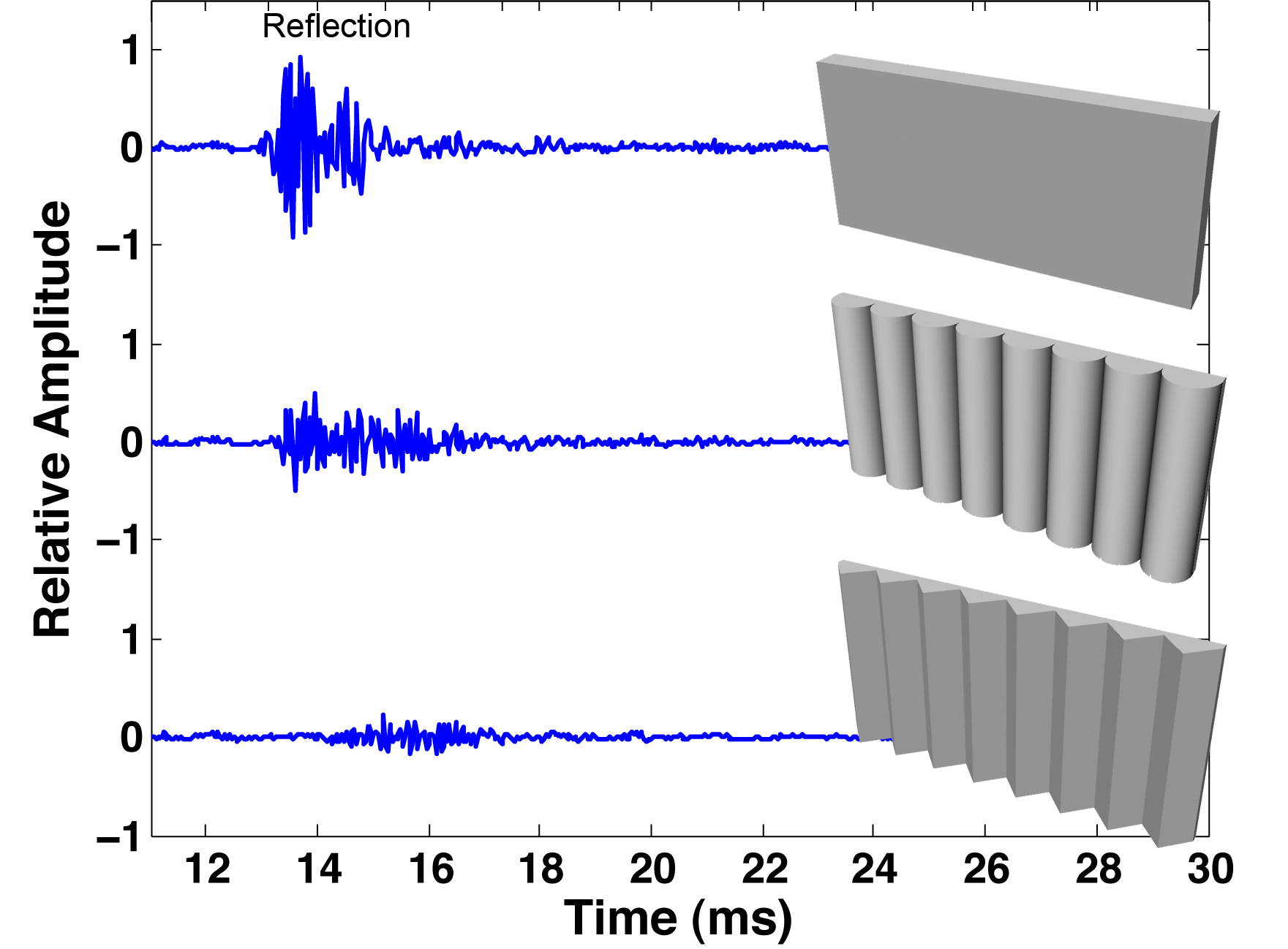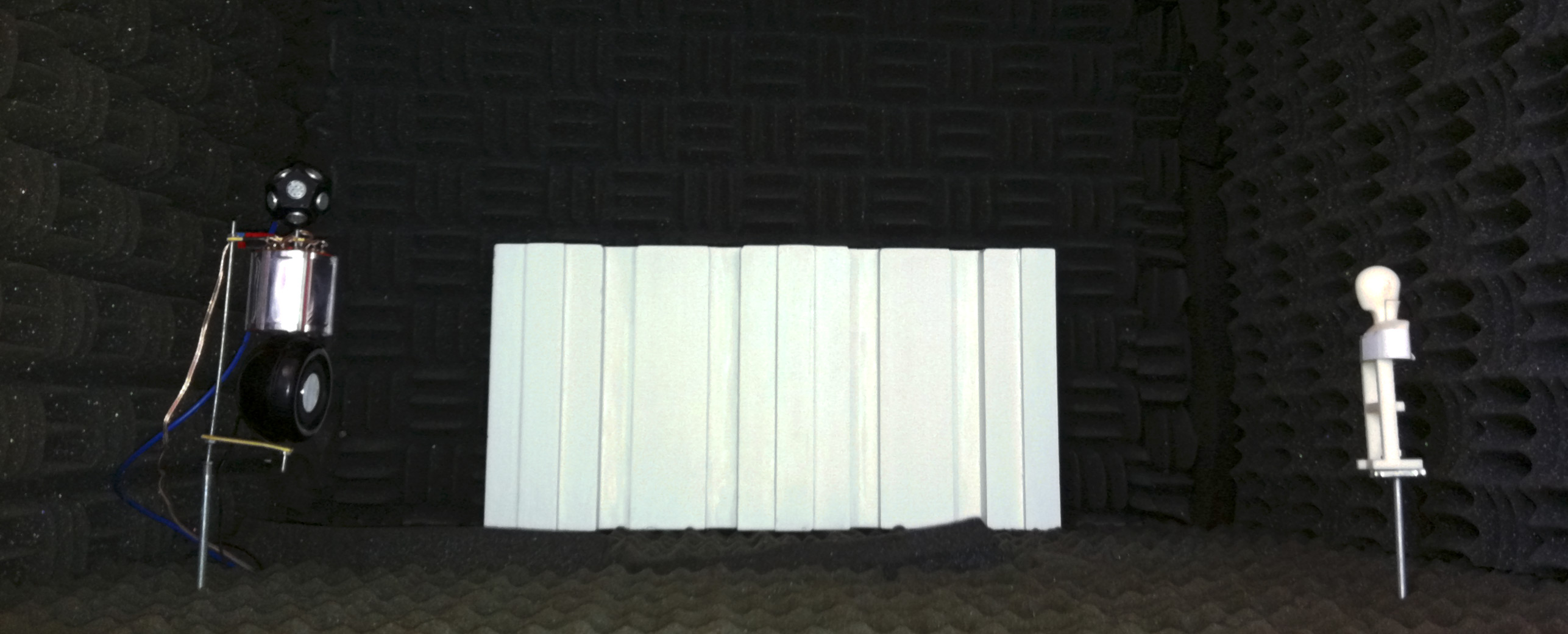
Philip W. Robinson – philrob22@gmail.com
Ning Xiang – xiangn@rpi.edu
Jonas Braasch – braasj@rpi.edu
Rensselaer Polytechnic Institute
110 8th St. - Greene Building
Troy, NY 12180
Popular version of paper 3aAAa7
Presented Wednesday morning, May 25, 2011
161st ASA Meeting, Seattle, Wash.
I. INTRODUCTION
When listening in rooms, one hears not only the sound that travels directly from the
source to his or her ears, but also a collection of reflections from the enclosing wall surfaces. The
auditory system interprets this agglomeration of sonic energy in different ways, depending on the
temporal and spatial distribution of the reflected energy. A strong reflection that arrives too long
after the direct sound is interpreted as a separate sound source located at the reflecting surface: an
echo. If a reflection is not disconnected from the original sound source as an echo, it may contribute
to the perceived width or size of the sound source, to one’s sense of being enveloped by the sound,
or to the clarity and intelligibility of the sound content. It is important to understand perceptual
responses to sound fields within different enclosures in order to appropriately design spaces for
music and speech communication. Figure 1 presents visual analogies for spatial auditory perception
of music and speech in two different rooms.
Reflections from architectural surfaces are not simply copies of the original sound signal. Walls absorb some of the sound that hits them, and different frequencies are filtered to different degrees. Also rough, curved, or articulated surfaces will return different frequencies at slightly different delays, thereby spreading out the sound energy in time. The majority of psychological studies that have investigated perception of sound in rooms have utilized ideal reflections from flat walls, calculated using simplified geometrical principles. This paper investigates methods to examine the perceptual effect of reflections from complex architectural surfaces. Figure 2 illustrates measured reflection patterns from three different surfaces.
Since auditory memory is short, room conditions must be simulated in the laboratory to allow direct side-by-side comparisons. This is possible through the process of auralization, whereby the measured or calculated properties of a room or surface are convolved with music or speech. Through an appropriate reproduction system, like an ambisonics or wave field synthesis array, or specially equalized headphones, one can listen to what it would sound like in various rooms, and make comparative judgments. Several techniques are available to simulate reflections from complex surfaces including numerical calculations, scale model measurements, and full scale measurements. This paper focuses on techniques using scale model measurements and full scale measurements.

FIG. 1. Visual analogs for acoustic perception in rooms. The shape and material of architectural surfaces
influence the way the human auditory system interprets reflected sound signals. The conditions illustrated
here do not represent research findings but serve to demonstrate the nature of the research.(Some
portions of this image were derived from a Creative Commons licensed photograph by: Nicky Nylon)

FIG. 2. Reflections measured from three different surfaces. Surface features alter the amplitude and temporal
distribution of the sound energy; this may lead to different perceptual responses.
II. BINAURAL SCALE MODELING
Due to the properties of sound waves, if a room enclosure or architectural surface is scaled down as a model, and the sound frequencies are scaled up by the same factor, the acoustic behavior in the scale model will be the same as in the full size case. By this method, many variations of room or surface geometries can be measured and compared without the prohibitive expense of extensive construction. Recording sped up speech or music in a scale model then playing it back at regular speed allows one to listen to what being in the full size version of the model would sound like. In this case, the recording device is a miniature artificial head with embedded microphones that records sound in the same manner human ears receive it: binaurally. Playback of the scaled binaural signal is then presented to listeners over headphones, hence binaural scale modeling. Figure 3 illustrates a scale model measurement setup for capturing a single reflection from an architectural wall panel. This apparatus was used to measure the reflections shown in Figure 2.

FIG. 3. A scale model anechoic chamber for measuring reflections from a single acoustic diffusor panel. The source on the left emits acoustic frequencies from 400 Hz to 160 kHz, that can then be scaled to the range of human hearing 20 Hz to 20 kHz. The miniature head on the right has embedded microphones for making binaural recordings for headphone playback. (Photo: Philip Robinson)
III. ROOM MEASUREMENTS
Another method to evaluate the perceptual effect of a particular wall or surface is to take acoustic measurements of the room in question, change the surface, and measure again. These measurements can then be used to create sound samples of the room before and after the change. Particularly in music halls or theaters, there are several key surfaces that reflect and thereby project the source into the audience. The surfaces around the proscenium, the sidewalls and overhead canopies all have a significant influence on the way a room filters sound to the listener. For this reason, it can be a fruitful investigation to listen to multiple architectural treatment variations for these key surfaces. Figure 4 illustrates easurements of variations of a theater proscenium splay.

FIG. 4. Measurement of a theater to examine the perceptual effect of the proscenium splay surfaces. The surfaces of the theater are designed to be highly diffusive, selected surfaces were covered with absorptive material, and flat rigid panels. These measurements will be used to create auralizations for comparative listening. (Photo: HyungSuk Jang)
IV. DISENTANGLING ABSORPTION
One consideration in examining the effect of the geometry of a surface is the need to disentangle the effect of absorption. In comparison to flat wall surfaces, diffusive surfaces present additional surface area, hence additional sound absorption. In addition, sound waves’ interaction with complex surfaces and edges attenuates the incident sound further. If a perceptual difference is noticed between a flat wall and one with irregular geometry, it will not be immediately apparent whether this is due to the temporal redistribution of the sound or the reduced sound energy. For this reason, additional energy must be added to the isolated reflections or the reflected portion of a room response. The additional energy added varies by frequency, but if the resulting energy spectrums of the flat and diffuse rooms is equal, then it can be safely assumed that perceived differences are the result of the temporal distribution of energy rather than the total sound energy.
V. CONCLUDING REMARKS
With acoustic measurements of real or scale model surfaces or rooms, simulations can be created. These simulations can be used for comparative listening tests to evaluate the effect of different surfaces, or systematic variations of architectural designs. The knowledge gained from this type of research can be applied to create an optimal listening condition in many listening venues, from traditional concert and lecture halls to dynamic virtual environments like video games and telecommunications. Future research will investigate systematic geometric enclosure variations on specific auditory phenomena, like our ability to localize a sound source, distinguish one sound source from another, or decipher speech over background noise.
VII. ACKNOWLEDGEMENTS
Thanks to the Architectural Acoustics group at Hanyang University, Seoul, South Korea, for access to the Sejong Arts Center M-Theater and for assistance with acoustic measurements.
VII. FURTHER READING
1 T. Cox and P. D’Antonio, Acoustic Absorbers and Diffusers: Theory, Design and Application, 2nd Edition
(Taylor & Francis, London) (2009).
2 Michael Vorländer, Auralization: Fundamentals of Acoustics, Modelling, Simulation, Algorithms and Acoustic Virtual Reality (Springer-Verlag, Berlin) (2008).
3 M. Barron, Auditorium acoustics and architectural design (Spon Press, London) (2004).
4 J. Blauert, Spatial hearing the psychophysiscs of human sound localization (MIT Press, Cambridge, Mass.)
(1999)
ABSTRACT
Acoustic diffusers have been applied in rooms for echo elimination and reduction of spatial variation, but perceptual effects are not fully understood. At worst, diffusive surfaces have been blamed
for tonal distortion and coloration, while other studies have found high correlation between preferred concert halls and diffusive interior surfaces. Evaluating perceptual effects of diffusive surfaces
presents several unique challenges. While many geometric acoustic modeling programs incorporate
spatial scattering algorithms which produce perceivable differences in auralization results, and may
accurately reproduce acoustic parameters of real halls, these differences are not necessarily representative of the perceptual effects of diffuser application in rooms. Accurate investigations of diffusion
can be conducted using real or scale model room measurements, but equalization must be performed
to isolate the independent effects of scattering and absorption. This paper presents experimental
methods to objectively gauge the perceptual effect of scattering surfaces.